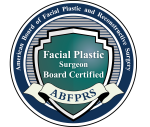Rosacea is a common skin condition which affects the skin of the face. Patients with rosacea experience episodic episodes of redness of the skin, commonly on the nose, cheeks, forehead, and chin. Over time, rosacea can progress with the development of tiny red bumps and pimples. It is not uncommon for patients to report the development of “adult acne.”
Who gets Rosacea?
According to the U.S. government more than 14 million people suffer from rosacea. The majority of patients are:
- Between 30-50 years of age
- Fair skinned with blonde hair and blue eyes
- Have a family history of rosacea or severe acne
- Women slightly more affected than men.
Rosacea Symptoms
Common symptoms of rosacea include:
- Episodic redness or flushing of the face
- Bumps or pimples on the face
- Visible blood vessels on the face and nose (telangectasias)
- Thickness and coarseness of skin
- red, dry, irritated, and swollen eyes
In the majority of cases, rosacea symptoms are episodic last a few weeks to months with symptom free intervals.

Quality of Life Impact of Rosacea
Rosacea is a chronic skin disease which left untreated, can result in a decreased quality of life. Surveys and studies report patients living with rosacea can suffer from
- Anxiety and depression
- Frustration and embarrassment
- Worry
- Low self-esteem
- Work-related problems
Fortunately, studies have shown that when people have fewer signs and symptoms of rosacae, the quality of life improves.
Rosacea Treatment Options
Unfortunately, there is currently no cure for rosacea. However, there area several treatment options which help patients manage their symptoms.
- Avoidance of “Triggers”- Some patients are able to identify triggers (exercise, alcohol, spicy foods, wind and cold, stress) associated with their flair ups. Avoidance of these triggers is important to minimize symptoms of rosacea.
- Sun protection-most patients with rosacea experience sensitivity to the sun. Protecting the skin from the sun is therefore important to optimize the skin health and appearance. This includes: applying a broad spectrum sunscreen with SPF 30-50, avoiding midday peak sun exposure, wearing hats when outdoors, and using sun protective clothing and sunglasses
- Medications-antibiotic medications, creams, gels, or lotions are used for patients suffering from advanced stages of rosacea to help control acne and improve their appearance
- Skin lasers-Laser treatments are commonly used to improve the appearance of facial redness and reduce blood vessels. Not only do they improve the appearance of the skin but skin lasers can help reduce the severity and frequency of flair ups. Common skin lasers utilized in the treatment of rosacea include IPL (photofacial) and KTP lasers.
To learn more about rosacea treatments in Orange County, contact our office at 949-273-3112 to schedule your consultation with Dr. Boeckmann.


